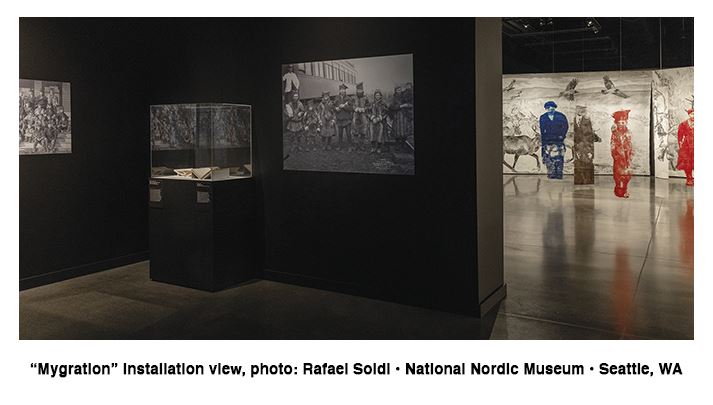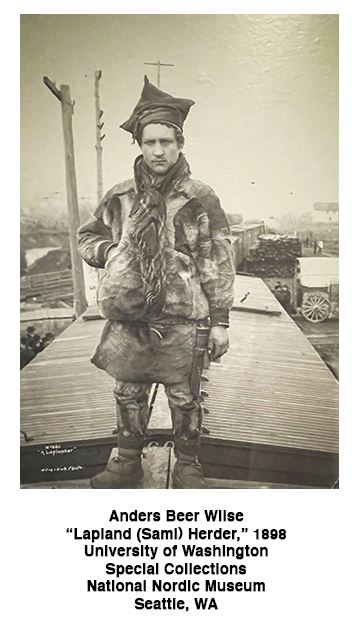
 In March 1898, Woodland Park visitors would have seen a surprising sight: Sámi reindeer herders and their reindeer. They came from what was then called Lapland, in Scandinavia, on a contract to teach reindeer herding to Alaskan natives! The expedition had the dramatic title of the “Lapland-Yukon Relief Expedition.”
In March 1898, Woodland Park visitors would have seen a surprising sight: Sámi reindeer herders and their reindeer. They came from what was then called Lapland, in Scandinavia, on a contract to teach reindeer herding to Alaskan natives! The expedition had the dramatic title of the “Lapland-Yukon Relief Expedition.”
The expedition was the idea of Sheldon Jackson, General Agent for Education in Alaska. He spread the myth that Alaskan Natives were starving, for an earlier expedition. In 1898, it was supposedly the Gold Miners who were starving, both ploys to raise money. But his agenda was actually part of the late 19th century efforts to “civilize” and assimilate Native peoples-in this case the Alaskan natives, who had not been touched by boarding school policies in the lower 48 states.
Initially the expedition included 87 Lapps (now called Sámi), some Finns and Swedes and 530 reindeer. The Sámi were touted as “model” Indigenous people as they travelled across the sea and across the country. By the time they reached Seattle many of the reindeer died of starvation because their diet of lichen was not available.
A group photo by Anders Beer
Wilse in the introductory gallery of “Mygration,” documents about twenty herders (it isn’t clear if that was all that survived), along with their families, including very young children. The herders stand out in their distinctive crown-like hats and clothing made of reindeer hide.
 Sámi artist Tomas Colbengtson transfers and transforms these historic Sámi photos onto small ceramic works that are displayed under the photographs. Colbengtson is South Sámi and grew up in a tiny village in central Sweden. Another ceramic work depicts the reindeer, and a rendering of a figure perhaps based on a ritual drum (one of which you can also see elsewhere at the Nordic Museum).
Sámi artist Tomas Colbengtson transfers and transforms these historic Sámi photos onto small ceramic works that are displayed under the photographs. Colbengtson is South Sámi and grew up in a tiny village in central Sweden. Another ceramic work depicts the reindeer, and a rendering of a figure perhaps based on a ritual drum (one of which you can also see elsewhere at the Nordic Museum).
In the second gallery, there is a dramatic shift in scale: Stina Folkebrant’s life size paintings of reindeer in subtle shades of gray surround us. Although she works in acrylic,the artist was inspired by Chinese ink painting. Folkebrant emphasizes the relationships of animals and humans and here, indeed, we feel that we are wandering in a field of reindeer. Each large painting presents one of the eight seasons of the Sámi.
Hanging in the center of the gallery are transparent plexiglass panels as well as a panel with a mirror in the center, all suspended from the ceiling and in constant motion. Here Colbengtson transferred Sámi photographs onto plexiglass (one panel is Dr. Shelton Jackson). Herders seem to move among the life size reindeer in the paintings as the panels move. We are also reflected in the mirror in the center and become part of the movement.
 The artists state that they are evoking the Sámi concept of circular time and herd mentality “Reindeer are herd animals and being together offers protection from danger. The whole herd becomes a single organism with a thousand eyes that can detect danger; if one turns around, the others follow. People are also herd animals; they want a sense of belonging.”
The artists state that they are evoking the Sámi concept of circular time and herd mentality “Reindeer are herd animals and being together offers protection from danger. The whole herd becomes a single organism with a thousand eyes that can detect danger; if one turns around, the others follow. People are also herd animals; they want a sense of belonging.”
The story of the Sámi and the reindeer in Alaska follows many twists and turns. After decades of various powerplays (such as a Gold Rush family taking over reindeer herding and profiting from reindeer products), eventually, the Alaska Natives were given the herds to own, and they let them go to join their caribou cousins. In other words instead of assimilation to white man’s ways, they assimilated the reindeer to their own habitat.
Some Sámi stayed in Alaska and inter-married with the Indigenous people. They are still very much part of Alaska today as evidenced in a recent exhibit in Juneau.
“Mygration” is a celebration of reindeer and the traditional relationship of Sámi as herders to these animals. As the moving plexiglass images of the Sámi intersect with the reindeer the installation perfectly conveys the magic of nomadic herders of reindeer.
Susan Noyes Platt
Susan Noyes Platt writes a blog www.artandpoliticsnow.com and for local, national, and international publications.

“Mygration” is on view Tuesday through Sunday from 10 A.M. to 5 P.M. until March 5 at the National Nordic Museum, located at 2655 Market Street in Seattle, Washington. For information, visit www.nordicmuseum.org.